Early History of Three Springs
The traditional owners of Three Springs are the Amangu, a language group of Aboriginal people from across parts of Western Australia's Mid West region.
The district of Three Springs received its name after three freshwater springs situated about one mile north of what is now the Three Springs townsite. The area of the springs had been surveyed by Sir John Forrest in 1872 and in his sixth Field Book he showed "the Three Springs" on Victoria Location 482. Prior to 1906 pastoralists ran livestock on portions of the district and the only resident settlers were a few railway employees of the Midland Railway Company.
The government had plans for an experimental farm west of the railway line, but instead threw it open for selection in 1906 under the name of the Kadathinni Agricultural Area. The first seven men who made an application to take up land for farming were Walter Browning, John Richardson, Charlie Thomas, Reuben Carter, Ernie Klopper, Harry Maley and Sol Maley.
The first to take up residence on his holding was Reuben Carter, who arrived with his wife Leah and their son Herbert on Saint Patrick’s Day in 1906. After making a makeshift home Charlie Thomas, his wife Winifred and their six children shifted to their holding on 8 April 1906. Other settlers who followed included Franklin Bros, Steve Morgan, Harry Richardson, Bill Howard, Jack Wilson, Gillie Haines, Jamie Hebiton, Ernie Klopper, Sol Maley, Charlie Maley and Ike Wallace.
In 1909 the Midland Railway Company surveyed and put up for sale a large area east of the railway line that had previously been leased by Micky Brown. This resulted in a second influx of settlers including Philip Lynch, George Watson, Arthur Glyde, Bastian Bros, Charles Gooch, Harry Page, Fred Sluggett, Walter Oates, Fred Hornsby, Frank Arndt, Bob Caldow and Billy Dean.
The first wheat crop in the Kadathinni Agricultural Area was fifteen acres grown and cut for hay by Charles F. Thomas in 1906. Rainfall records were inaugurated in 1907 and kept by Jack Hebiton.
The first public body was the Kadathinni Farmers & Progress Association which was formed in 1908. Gillie Haines and Charlie Thomas were the Association’s first chairman and secretary, and in 1909 were respectively followed by Steve Morgan and Evander Franklin. The progress association did much to advance the district in which the needs of the new settlement were many and the amenities few. In 1911 some of its accomplishments were the construction of the first town dam, the appointment of a resident police officer (Const. William Walker), and the appointment of a local Justice of the Peace (Jamie Hebiton Snr). Other local organisations formed included football and race clubs in 1910, and a rifle club in 1915.
Initially there was only a railway siding at Three Springs, with trains stopping to let down passengers or when called upon to do so. Trains were stopped by the intending passenger holding up a red disc in the daytime or a light at night. Following the district’s advancement and increased settlement the Midland Railway Company upgraded the siding to a station in 1910, and Artie Mortimer was transferred to Three Springs to fulfill the duties of stationmaster.
The district made rapid growth for several years. The first school was a private one on Charlie Thomas’ farm, the teacher being Charles Howes, known to the early settlers as "Le Grondeur". A state school was opened in the townsite in the latter part of 1908, the first teacher being Miss Dagmar Koch, who in 1910 was succeeded by Arthur Green. A Dominican Convent, including a school, was established in Three Springs in 1917.
The first shop, which was a newsagency, was opened in 1909 by Joe Brown and initially conducted by Charles McKay (a Scot known as “Old Mac”). Later in 1909 a small general store was opened by Joseph Groffier and Septimus Pizey, trading as Groffier & Pizey. In the same year Dave Todd opened a blacksmith’s shop. Dave was an excellent tradesman and helped in no small measure in the development of the district by making and mending farmers’ requisites in the old horse team days. Also in 1909 Mike Ryan opened a general store in the building later occupied by the Duffy family. Mick conducted his store successfully for several years and almost acquired fame by the quaint sign over his door, which told all and sundry that it was "Mick Ryan’s Unlimited Credit Store". Mick spent valuable time explaining to good buyers with no money that he wanted them to see unlimited credit.
Steve Sheridan opened a general store in late 1909 or early 1910, which he later ran in partnership with his son-in-law Joe Brown. They sold the business to Bill Harris in 1911, who afterwards sold it to Jimmy Whitelaw. Later again, in 1920, it was sold to the North Midlands Farmers’ Co-Operative Company Limited, who used it for their store until having new premises built in 1941. Among the first managers of the Co-Op store were Charlie Wright, John Donnes, Jamie Hebiton Snr, Norman Skewes, Harold Barnett and Harry Smith.
By mid 1910 Mrs Blanche Koch had opened a tearooms and boarding house known as the Three Springs Coffee Palace, which she successfully operated until 1932 when it was taken over by her daughter Mrs Clare Black. Also during the year 1910 a bakery was established by Ike Wallace, and Albert Carlisle opened a photographic studio. In 1911 another store was opened by Tom Berrigan, who also carried machinery, stock, insurance and other agencies. EK Byrne opened a butcher’s shop in 1911, which was conducted by his elder sons and briefly by a few others until 1919 when it was taken over by Tom Bickell.
In 1910 Mrs Jane Terry established the Commercial Hotel with a wine and beer license and in 1911, after extensive alterations, secured a general publican’s license. The hotel was later conducted by Lewis Hasell, Bill Angove, Nat McKenzie, Frank McDonald, Randolph Barnhart (who had new hotel premises built), Vincent Tippett, William Duncan and Jack Thorpe.
Mrs Daisy Starling, wife of the local railway ganger, acted as mail receiver as early as 1907. A postal service was later given by Mrs Blanche Koch and Miss Clare Koch, the mother and sister of the first state school teacher. During the latter part of 1910 the first official post and telegraph office was opened in part of the local store owned by Brown & Sheridan. Charles Nicholson was the first postmaster and filled the position until May 1912, when Charlie Luscombe took over and carried on until his retirement in September 1947. About 1913 the post office was moved to a house on Touche Street, formerly occupied by Steve Sheridan, business being conducted through a window with a ledge on the front verandah for about four or five years, after which a separate room for postal business was built on land alongside the house. This house, also previously used as the postmaster’s quarters, was now used solely for this purpose. During 1914 telephone facilities were established with six subscribers, and shortly afterwards private boxes were installed. After many applications and deputations Three Springs was granted new official post office premises, which were opened by Senator Paddy Lynch of Three Springs on 12 August 1938.
The National Bank of Australasia Limited opened a receiving office in Three Springs in 1909, and a branch in 1926. Among the branch’s earliest managers were Maurie Buck, Charles Macdonald, John Kelleher, Keith Whitlock and Christopher Thomas. In 1928 the English, Scottish & Australian (E., S. & A.) Bank established its first Western Australian country branch at Three Springs. The local E. S. & A. Bank was managed by Jumbo Evans for three years and then by Ray Shaw.
The first town hall, known as the Agricultural Hall, was built by a contractor named Brock and was opened on 29 June 1912. The opening ceremony was performed by James Gardiner who was the Midland Railway Company’s Land Agent and later the local member for the Legislative Assembly. The hall cost £650, with the Government subsidising the building of agricultural halls on a pound for pound basis. The music for the dance which followed the opening ceremony was provided by Miss Winnie Thomas. One speech made at the function was a toast to "Town and Trade," proposed by the then resident school teacher. The speaker emphasised how grateful the residents were to the business people, who came out into a new area, risked their money in setting up a business and catered for the settlers’ needs, adding that even if they charged 300% more for their goods than applied elsewhere the settlers were still grateful to them for the service they rendered.
In the early days of the settlement a sports meeting known as the "Three Springs Day" was held on the third Thursday in September, with Charlie Thomas Snr as secretary. In 1927 the Three Springs Agricultural Society was formed and held its first show on 20 September 1928. This fixture took the place of the Three Springs Day, the secretarial duties for the show also initially being carried out by Charlie Thomas. Other events in the early years included the annual race meeting conducted by the Three Springs Race Club, and a race and sports meeting held each year on Saint Patrick’s Day.
The early settlers of the Roman Catholic Church were cared for by Rev. Fathers O’Heir, Ahern and Scanlon. A Roman Catholic Church was built in 1911 and a Dominican Convent opened on 28 January 1917. The Three Springs Parish was created in 1921, the first Parish Priest being the Rev. Father Mark Hart, who was followed by Rev. Fathers James Tymons, John Flahavan, Michael Lynch and Bryan Gallagher. The first resident Methodist Missioner was appointed in 1914 and was Rev. James Bayliss. Rev. Bayliss was succeeded by Horace Weavers, James Elms, Henry Christiansen, Alex James and Thomas Cook. The spiritual welfare of the Anglican settlers was initially cared for by the Rev. Ernest Gill of Dongara, a quaint old Anglican Minister, who made periodical visits as far as Three Springs. Rev. Gill was succeeded in Dongara by Rev. Walter Kenworthy, who also visited Three Springs. A very keen worker for the local Anglican church in the early days was Mrs Blanche Koch. In 1928 a rectory was built in Three Springs and Godfrey Jaquet travelled from England to became the district’s first resident rector. The Anglican Church of Saint James in Three Springs was licensed on 15 April 1932 by the Most Rev. Henry F. Le Fanu, the second Archbishop of Perth. The locally raised funds towards the Church were due largely to the enthusiasm of Mrs Maude James. Following Rev. Jaquet's departure the Parish was conducted by Rev. Edward Chard and then Rev. Alfred Toomey.
The district’s first doctor was Dr James McAleer, later the Mayor of Geraldton, who commenced practice in Three Springs in 1921. In 1924 a cottage hospital was opened in a farmhouse on Charlie Maley’s Parakalia Farm about one mile west of the town. The cottage hospital was later moved to another farmhouse about one mile north-east of the town, and also owned by Charlie Maley. Following Dr McAleer’s departure Dr Mario Mayrhofer faithfully served the district as resident doctor from mid 1926 until his death in 1950. In 1926 a meeting was held to have a new official hospital built. The building committee consisted of Dr Mario Mayrhofer (chairman), Keith Glyde, Syd Gooch, Bert Strutton and Jamie Hebiton (secretary). The North Midlands District Hospital was opened four years later on 27 June 1930. The building cost £4,410, of which £2,204 was subsidised by the Government. The locally raised portion was obtained mainly through subscriptions, the largest of £200 coming from the North Midlands Farmers’ Co-Operative Company Limited. In 1937 nurse's quarters were built alongside the hospital.
In 1929 an electric light and power station was established in the Three Springs townsite by Henry Parkin & Son of Carnamah. The power station was later conducted by William Rogers, Leslie Carter and Arthur Dargin. The station received a concession from the Three Springs Road Board conditional to it providing certain services, such as lighting street lights at night and providing a full day of power one day a week for domestic ironing purposes!
As a wheat growing district Three Springs soon proved its worth. In 1931-32 the Three Springs district obtained the highest average yield for the State, and this achievement was commemorated by a dinner arranged by the wheat growers of the district and held at the Commercial Hotel on 26 August 1932. At a World Grain Exhibition held in Canada in 1933 two prizes were won by Three Springs farmers in Evander Franklin and Jamie Hebiton Snr.
Initially Three Springs was part of the Upper Irwin Road Board, which was based at Mingenew and in 1919 was renamed the Mingenew Road Board. Three Springs farmers Charlie Maley, Frank Morgan and Fred James all served terms representing the district as members on the Upper Irwin / Mingenew Road Board. In 1923 the southern portion of this Road Board, spanning from Three Springs to Gunyidi, broke away to bocame the Carnamah District Road Board. Archie Bastian and Fred James were the Foundation Members for Three Springs on the Carnamah District Road Board, and Fred James was Chairman of the Board in 1925 and 1926. Others who represented Three Springs on the Carnamah District Road Board were Nat McKenzie, EK Byrne and Evander Franklin. In 1929 a Road Board was formed at Three Springs consisting of Three Springs, Arrino and Dudawa. The inaugural members of the Three Springs Road Board were Edward Hunt (chairman), EK Byrne, William Smith, Bert Broad, Bill Mutter, Charlie Thomas Snr and Harry Sweetman. Following a change in the Local Government Act the Three Springs Road Board became the Three Springs Shire Council in 1961.
Related Content
● Biographical Dictionary of Three Springs
● Burials at Three Springs General Cemetery
● Three Springs Centenary Collection (photos)
● Blog Post on the story of Bulk Wheat Handling
● Early Histories of Carnamah and Coorow
About This History
The above history is an adapted version of the "History of Three Springs" that appeared in the Souvenir Booklet from the opening of the Three Springs Road Board Hall in 1949. The history had been provided by local old-timers Jamie Hebiton Snr, Evander Franklin, Charlie Thomas Jnr and Charlie Luscombe.
The booklet was published by the Three Springs-Arrino Sub-Branch of the R.S.L. and has been re-produced in an edited format with their kind permission. This version was edited, revised and expanded by Andrew Bowman-Bright in 2006.
The photographs on this page are from the Three Springs Historical Society. They were part of the Three Springs Centenary Collection which was put together by Judy Mutter for the district's centenary in 2006.
The traditional owners of Three Springs are the Amangu, a language group of Aboriginal people from across parts of Western Australia's Mid West region.
The district of Three Springs received its name after three freshwater springs situated about one mile north of what is now the Three Springs townsite. The area of the springs had been surveyed by Sir John Forrest in 1872 and in his sixth Field Book he showed "the Three Springs" on Victoria Location 482. Prior to 1906 pastoralists ran livestock on portions of the district and the only resident settlers were a few railway employees of the Midland Railway Company.
The government had plans for an experimental farm west of the railway line, but instead threw it open for selection in 1906 under the name of the Kadathinni Agricultural Area. The first seven men who made an application to take up land for farming were Walter Browning, John Richardson, Charlie Thomas, Reuben Carter, Ernie Klopper, Harry Maley and Sol Maley.
The first to take up residence on his holding was Reuben Carter, who arrived with his wife Leah and their son Herbert on Saint Patrick’s Day in 1906. After making a makeshift home Charlie Thomas, his wife Winifred and their six children shifted to their holding on 8 April 1906. Other settlers who followed included Franklin Bros, Steve Morgan, Harry Richardson, Bill Howard, Jack Wilson, Gillie Haines, Jamie Hebiton, Ernie Klopper, Sol Maley, Charlie Maley and Ike Wallace.
In 1909 the Midland Railway Company surveyed and put up for sale a large area east of the railway line that had previously been leased by Micky Brown. This resulted in a second influx of settlers including Philip Lynch, George Watson, Arthur Glyde, Bastian Bros, Charles Gooch, Harry Page, Fred Sluggett, Walter Oates, Fred Hornsby, Frank Arndt, Bob Caldow and Billy Dean.
The first wheat crop in the Kadathinni Agricultural Area was fifteen acres grown and cut for hay by Charles F. Thomas in 1906. Rainfall records were inaugurated in 1907 and kept by Jack Hebiton.
The first public body was the Kadathinni Farmers & Progress Association which was formed in 1908. Gillie Haines and Charlie Thomas were the Association’s first chairman and secretary, and in 1909 were respectively followed by Steve Morgan and Evander Franklin. The progress association did much to advance the district in which the needs of the new settlement were many and the amenities few. In 1911 some of its accomplishments were the construction of the first town dam, the appointment of a resident police officer (Const. William Walker), and the appointment of a local Justice of the Peace (Jamie Hebiton Snr). Other local organisations formed included football and race clubs in 1910, and a rifle club in 1915.
Initially there was only a railway siding at Three Springs, with trains stopping to let down passengers or when called upon to do so. Trains were stopped by the intending passenger holding up a red disc in the daytime or a light at night. Following the district’s advancement and increased settlement the Midland Railway Company upgraded the siding to a station in 1910, and Artie Mortimer was transferred to Three Springs to fulfill the duties of stationmaster.
The district made rapid growth for several years. The first school was a private one on Charlie Thomas’ farm, the teacher being Charles Howes, known to the early settlers as "Le Grondeur". A state school was opened in the townsite in the latter part of 1908, the first teacher being Miss Dagmar Koch, who in 1910 was succeeded by Arthur Green. A Dominican Convent, including a school, was established in Three Springs in 1917.
The first shop, which was a newsagency, was opened in 1909 by Joe Brown and initially conducted by Charles McKay (a Scot known as “Old Mac”). Later in 1909 a small general store was opened by Joseph Groffier and Septimus Pizey, trading as Groffier & Pizey. In the same year Dave Todd opened a blacksmith’s shop. Dave was an excellent tradesman and helped in no small measure in the development of the district by making and mending farmers’ requisites in the old horse team days. Also in 1909 Mike Ryan opened a general store in the building later occupied by the Duffy family. Mick conducted his store successfully for several years and almost acquired fame by the quaint sign over his door, which told all and sundry that it was "Mick Ryan’s Unlimited Credit Store". Mick spent valuable time explaining to good buyers with no money that he wanted them to see unlimited credit.
Steve Sheridan opened a general store in late 1909 or early 1910, which he later ran in partnership with his son-in-law Joe Brown. They sold the business to Bill Harris in 1911, who afterwards sold it to Jimmy Whitelaw. Later again, in 1920, it was sold to the North Midlands Farmers’ Co-Operative Company Limited, who used it for their store until having new premises built in 1941. Among the first managers of the Co-Op store were Charlie Wright, John Donnes, Jamie Hebiton Snr, Norman Skewes, Harold Barnett and Harry Smith.
By mid 1910 Mrs Blanche Koch had opened a tearooms and boarding house known as the Three Springs Coffee Palace, which she successfully operated until 1932 when it was taken over by her daughter Mrs Clare Black. Also during the year 1910 a bakery was established by Ike Wallace, and Albert Carlisle opened a photographic studio. In 1911 another store was opened by Tom Berrigan, who also carried machinery, stock, insurance and other agencies. EK Byrne opened a butcher’s shop in 1911, which was conducted by his elder sons and briefly by a few others until 1919 when it was taken over by Tom Bickell.
In 1910 Mrs Jane Terry established the Commercial Hotel with a wine and beer license and in 1911, after extensive alterations, secured a general publican’s license. The hotel was later conducted by Lewis Hasell, Bill Angove, Nat McKenzie, Frank McDonald, Randolph Barnhart (who had new hotel premises built), Vincent Tippett, William Duncan and Jack Thorpe.
Mrs Daisy Starling, wife of the local railway ganger, acted as mail receiver as early as 1907. A postal service was later given by Mrs Blanche Koch and Miss Clare Koch, the mother and sister of the first state school teacher. During the latter part of 1910 the first official post and telegraph office was opened in part of the local store owned by Brown & Sheridan. Charles Nicholson was the first postmaster and filled the position until May 1912, when Charlie Luscombe took over and carried on until his retirement in September 1947. About 1913 the post office was moved to a house on Touche Street, formerly occupied by Steve Sheridan, business being conducted through a window with a ledge on the front verandah for about four or five years, after which a separate room for postal business was built on land alongside the house. This house, also previously used as the postmaster’s quarters, was now used solely for this purpose. During 1914 telephone facilities were established with six subscribers, and shortly afterwards private boxes were installed. After many applications and deputations Three Springs was granted new official post office premises, which were opened by Senator Paddy Lynch of Three Springs on 12 August 1938.
The National Bank of Australasia Limited opened a receiving office in Three Springs in 1909, and a branch in 1926. Among the branch’s earliest managers were Maurie Buck, Charles Macdonald, John Kelleher, Keith Whitlock and Christopher Thomas. In 1928 the English, Scottish & Australian (E., S. & A.) Bank established its first Western Australian country branch at Three Springs. The local E. S. & A. Bank was managed by Jumbo Evans for three years and then by Ray Shaw.
The first town hall, known as the Agricultural Hall, was built by a contractor named Brock and was opened on 29 June 1912. The opening ceremony was performed by James Gardiner who was the Midland Railway Company’s Land Agent and later the local member for the Legislative Assembly. The hall cost £650, with the Government subsidising the building of agricultural halls on a pound for pound basis. The music for the dance which followed the opening ceremony was provided by Miss Winnie Thomas. One speech made at the function was a toast to "Town and Trade," proposed by the then resident school teacher. The speaker emphasised how grateful the residents were to the business people, who came out into a new area, risked their money in setting up a business and catered for the settlers’ needs, adding that even if they charged 300% more for their goods than applied elsewhere the settlers were still grateful to them for the service they rendered.
In the early days of the settlement a sports meeting known as the "Three Springs Day" was held on the third Thursday in September, with Charlie Thomas Snr as secretary. In 1927 the Three Springs Agricultural Society was formed and held its first show on 20 September 1928. This fixture took the place of the Three Springs Day, the secretarial duties for the show also initially being carried out by Charlie Thomas. Other events in the early years included the annual race meeting conducted by the Three Springs Race Club, and a race and sports meeting held each year on Saint Patrick’s Day.
The early settlers of the Roman Catholic Church were cared for by Rev. Fathers O’Heir, Ahern and Scanlon. A Roman Catholic Church was built in 1911 and a Dominican Convent opened on 28 January 1917. The Three Springs Parish was created in 1921, the first Parish Priest being the Rev. Father Mark Hart, who was followed by Rev. Fathers James Tymons, John Flahavan, Michael Lynch and Bryan Gallagher. The first resident Methodist Missioner was appointed in 1914 and was Rev. James Bayliss. Rev. Bayliss was succeeded by Horace Weavers, James Elms, Henry Christiansen, Alex James and Thomas Cook. The spiritual welfare of the Anglican settlers was initially cared for by the Rev. Ernest Gill of Dongara, a quaint old Anglican Minister, who made periodical visits as far as Three Springs. Rev. Gill was succeeded in Dongara by Rev. Walter Kenworthy, who also visited Three Springs. A very keen worker for the local Anglican church in the early days was Mrs Blanche Koch. In 1928 a rectory was built in Three Springs and Godfrey Jaquet travelled from England to became the district’s first resident rector. The Anglican Church of Saint James in Three Springs was licensed on 15 April 1932 by the Most Rev. Henry F. Le Fanu, the second Archbishop of Perth. The locally raised funds towards the Church were due largely to the enthusiasm of Mrs Maude James. Following Rev. Jaquet's departure the Parish was conducted by Rev. Edward Chard and then Rev. Alfred Toomey.
The district’s first doctor was Dr James McAleer, later the Mayor of Geraldton, who commenced practice in Three Springs in 1921. In 1924 a cottage hospital was opened in a farmhouse on Charlie Maley’s Parakalia Farm about one mile west of the town. The cottage hospital was later moved to another farmhouse about one mile north-east of the town, and also owned by Charlie Maley. Following Dr McAleer’s departure Dr Mario Mayrhofer faithfully served the district as resident doctor from mid 1926 until his death in 1950. In 1926 a meeting was held to have a new official hospital built. The building committee consisted of Dr Mario Mayrhofer (chairman), Keith Glyde, Syd Gooch, Bert Strutton and Jamie Hebiton (secretary). The North Midlands District Hospital was opened four years later on 27 June 1930. The building cost £4,410, of which £2,204 was subsidised by the Government. The locally raised portion was obtained mainly through subscriptions, the largest of £200 coming from the North Midlands Farmers’ Co-Operative Company Limited. In 1937 nurse's quarters were built alongside the hospital.
In 1929 an electric light and power station was established in the Three Springs townsite by Henry Parkin & Son of Carnamah. The power station was later conducted by William Rogers, Leslie Carter and Arthur Dargin. The station received a concession from the Three Springs Road Board conditional to it providing certain services, such as lighting street lights at night and providing a full day of power one day a week for domestic ironing purposes!
As a wheat growing district Three Springs soon proved its worth. In 1931-32 the Three Springs district obtained the highest average yield for the State, and this achievement was commemorated by a dinner arranged by the wheat growers of the district and held at the Commercial Hotel on 26 August 1932. At a World Grain Exhibition held in Canada in 1933 two prizes were won by Three Springs farmers in Evander Franklin and Jamie Hebiton Snr.
Initially Three Springs was part of the Upper Irwin Road Board, which was based at Mingenew and in 1919 was renamed the Mingenew Road Board. Three Springs farmers Charlie Maley, Frank Morgan and Fred James all served terms representing the district as members on the Upper Irwin / Mingenew Road Board. In 1923 the southern portion of this Road Board, spanning from Three Springs to Gunyidi, broke away to bocame the Carnamah District Road Board. Archie Bastian and Fred James were the Foundation Members for Three Springs on the Carnamah District Road Board, and Fred James was Chairman of the Board in 1925 and 1926. Others who represented Three Springs on the Carnamah District Road Board were Nat McKenzie, EK Byrne and Evander Franklin. In 1929 a Road Board was formed at Three Springs consisting of Three Springs, Arrino and Dudawa. The inaugural members of the Three Springs Road Board were Edward Hunt (chairman), EK Byrne, William Smith, Bert Broad, Bill Mutter, Charlie Thomas Snr and Harry Sweetman. Following a change in the Local Government Act the Three Springs Road Board became the Three Springs Shire Council in 1961.
Related Content
● Biographical Dictionary of Three Springs
● Burials at Three Springs General Cemetery
● Three Springs Centenary Collection (photos)
● Blog Post on the story of Bulk Wheat Handling
● Early Histories of Carnamah and Coorow
About This History
The above history is an adapted version of the "History of Three Springs" that appeared in the Souvenir Booklet from the opening of the Three Springs Road Board Hall in 1949. The history had been provided by local old-timers Jamie Hebiton Snr, Evander Franklin, Charlie Thomas Jnr and Charlie Luscombe.
The booklet was published by the Three Springs-Arrino Sub-Branch of the R.S.L. and has been re-produced in an edited format with their kind permission. This version was edited, revised and expanded by Andrew Bowman-Bright in 2006.
The photographs on this page are from the Three Springs Historical Society. They were part of the Three Springs Centenary Collection which was put together by Judy Mutter for the district's centenary in 2006.
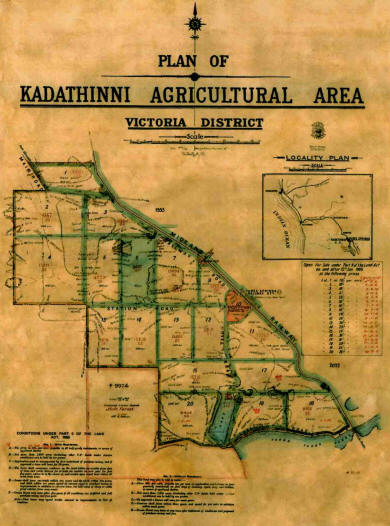
Plan of the Kadathinni Agricultural Area
on the western side of the Midland Railway
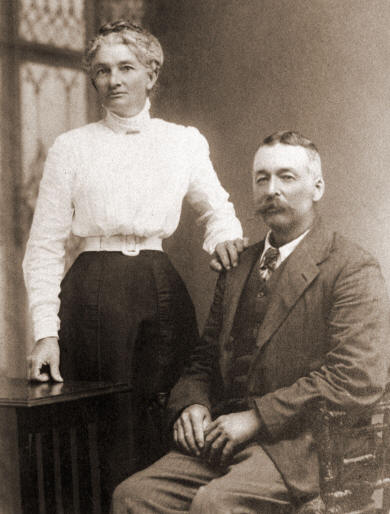
Leah & Reuben Carter
of Fairview Farm in Three Springs
Photo courtesy of Mrs Lois B. Lucas
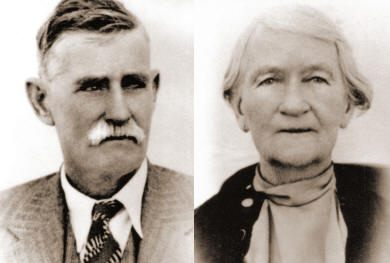
Charlie & Winifred Thomas
of Kadathinni Farm in Three Springs
Photo courtesy of Robert W. Hunt
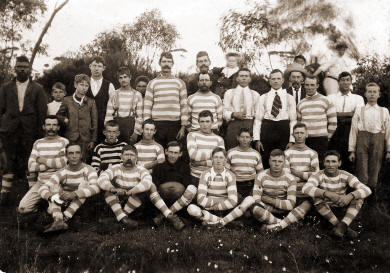
Inaugural Three Springs Football Team in 1909
Photo courtesy of the Shire of Three Springs
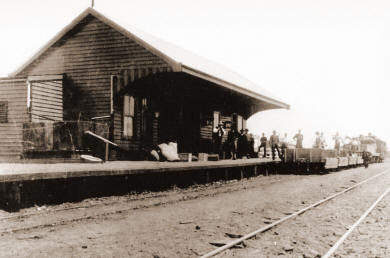
Three Springs Railway Station in 1917
Photo courtesy of Robert W. Hunt
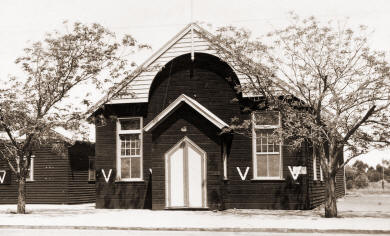
Agricultural Hall in Three Springs
Photo courtesy of
Geraldine L. & Anthony E. C. Thomas
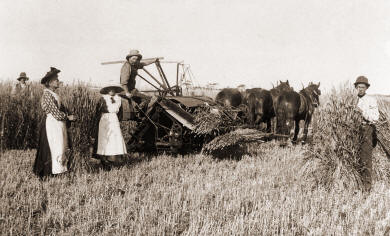
Hay cutting on Carter's Fairview Farm in 1909
Photo courtesy of Mrs Lois B. Lucas
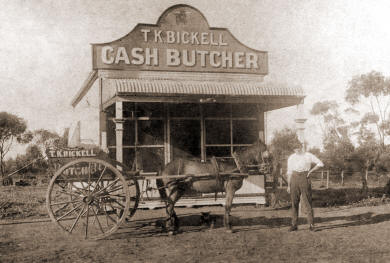
Butcher's Shop of Tom Bickell
on Slaughter Street in Three Springs C.1917
Photo courtesy of Clifford K. Bickell
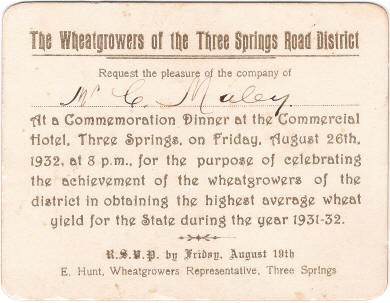
Invite to Commemoration Dinner to celebrate
Three Springs obtaining the highest average
wheat yield in WA for the 1931-32 season
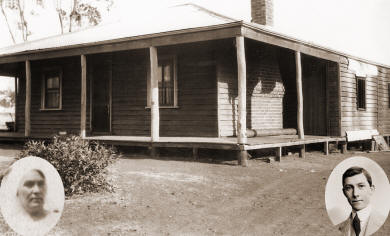
First Three Springs Hospital
Inset: Matron Toohey and Dr James McAleer
Photos respectively courtesy of Mrs Marie T. Sears,
Mrs Fay M. McKinnon and Anthony J. McAleer
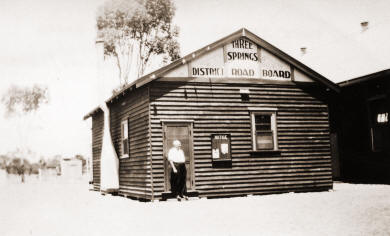
Three Springs District Road Board offices
Photo courtesy of I. Cochrane
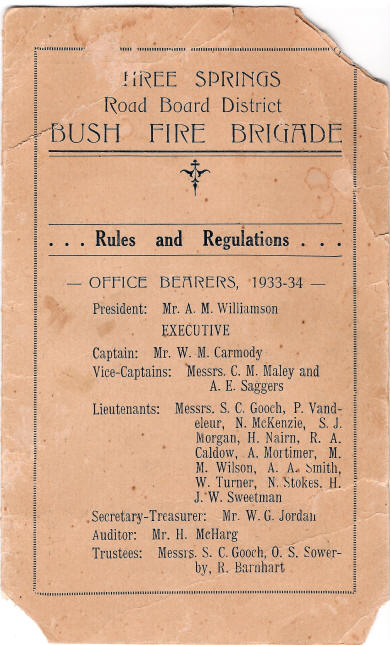
Cover of Three Springs Road Board District
Bush Fire Brigade 1933-34 Rules & Regulations
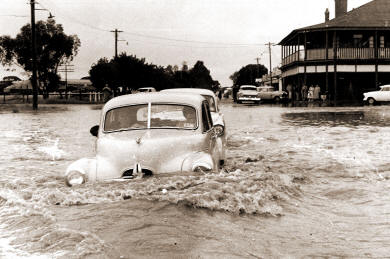
Flooding in Three Springs in about 1956
Photo courtesy of Marie Sears
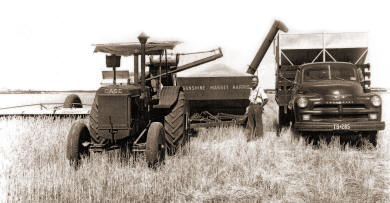
Harvesting in 1956 on Golden West Farm
Photo courtesy of Mrs Rhonda R. Stokes



